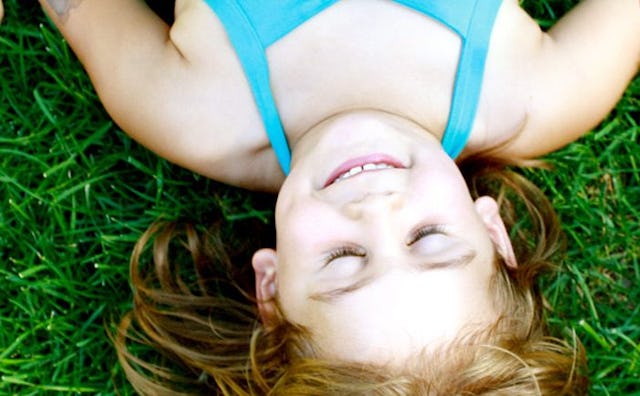Raising Free-Range Campers

“In the depth of winter, I finally learned that within me there lay an invincible summer.” –Albert Camus
When I was a child, my parents gave me the freedom to dream, create, and play by myself. Whether they understood the importance of unstructured outdoor play or just needed me to occupy myself, I appreciated the space.
One place I recall with fondness is a playground that was located near my dad’s old house in Georgia. There was a little metal merry-go-round we used for an unstructured game we called “flying monkeys,” which involved us seeing who could jump the farthest off it while it spun.
How to play flying monkeys:
1. Squat in the middle of a 1970s-era merry-go-round about the size of one of those Jazzercise trampolines.
2. Ask your friends to spin the merry-go-round as fast as they can.
3. When the spinners yell “GO!” attempt to stand. Fight the centripetal force pulling you back down to the center.
4. As you reach the edge, centrifugal force hurls you haphazardly off.
5. Dodge the metal animals that were meant to be sat upon and jump off the edge as far as you can.
If I’ve described it well, it sounds as impossible as it was. Most times we would either fall right away or attempt to jump and end up splayed off it halfway and need the spinners to perform an emergency stop. Regardless of the outcome, our end result would be to collapse in a heap of giggles.
After flying monkeys, we turned our attention to the surrounding wild. An impenetrable maze of kudzu vines and poison ivy ate the woods right up to the edge where the mower clipped them, but somehow the creek had been spared that sad fate, so we marched happily down to the water.
The creek was where our real adventures began. Sometimes we grabbed red clay from the shore and sculpted shapes. Eventually our works of art would harden into replicas of sandy red pea gravel at best, dried-up dog turds at worst. We jumped from bank to bank and waded in the cool, calf-deep water. When we tired of failing to catch water spiders, we wandered through the culvert to the shady unknown on the other side.
The excitement and trepidation of stepping foot into the slimy tube is one I will not soon forget. I would relive it all—the fear, the peer pressure, the anticipation, and the exhilaration—in a heartbeat. I remember how much colder it felt to go from the blazing Georgia sun into the depths of the dank, goose-pimply tunnel. My toes hugged the metal rungs as I tiptoed through; it seemed like forever until we came out on the other side. Once through the culvert, we fed off the energy of having survived the gauntlet by exploring the stream further. I have no memory of what lay beyond the culvert; the thrill of adventure was the only reward I required.
Looking back, I can’t remember my dad ever checking up on us. I am particularly impressed with, and grateful for, his ability to let us go off on our own. I guess he figured we couldn’t get into that much trouble in our own neighborhood. It wasn’t like we were setting off on a 5-mile walk into the woods or anything, but it felt dangerous enough to me as a 10-year-old.
Although they cast a wide net for me, my parents were allowed to explore an even larger space as kids without hindrance or restriction. One of my dad’s best memories of childhood is riding his bike to school in the first grade, even crossing a busy four-way intersection on the journey, which is something even I couldn’t imagine doing as a latchkey kid.
Go back another generation and the independence extends even further. My grandmother recalls building a hut with her siblings—in the 1930s—in a vacant lot across the street from her house in Miami. Her parents let her spend the night in it as a young child, without a care for scorpions or fire ants, not to mention the strangers who might have lurked about.
When I look at the tiny circle of trust I have thus far granted my own children, it seems impossible to me that we ever gave kids such freedom. Thus, even as the circle continues to shrink, I am fighting to raise free-range kids, who with luck will get some semblance of the space and trust I was afforded.
I recently registered the kids for my childhood summer camp, where, for the past two summers, I have returned with them to be a counselor again. Thinking of those hot days to come is my optimistic activity for surviving the bitter cold of this endless New England winter. I’m sorry to say that in the near-decade between my stints as counselor, the scale has tipped toward helicoptering. Kids are now expected to report their exact location during any period of time labeled “free,” thus removing the sense of freedom from the equation. I expect the camp staff must have endured plenty of parent complaints; parents today expect they can keep tabs on their children 24/7, even at camp.
Not me. I love the idea of the kids being “lost” down in a mud pit or wandering a creek somewhere. Therefore, as a counselor, I test boundaries where I can. Even though it takes getting permission from three people, gathering a cell phone and wilderness emergency bag, and making a list of who’s going, I take groups of kids into the wild unknown for a creek adventure.
After all, to the kids it’s just as wild as when I went on such excursions 20-plus years ago. Maybe what they don’t know can’t burden them. After all, what happens at camp stays at camp.
This piece was originally published on Heirloom Mothering.
This article was originally published on